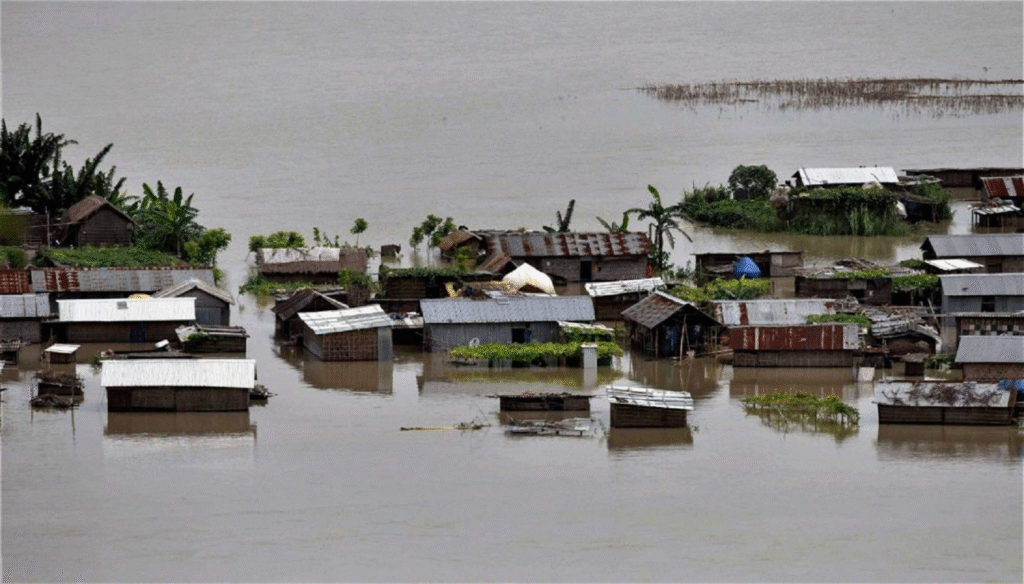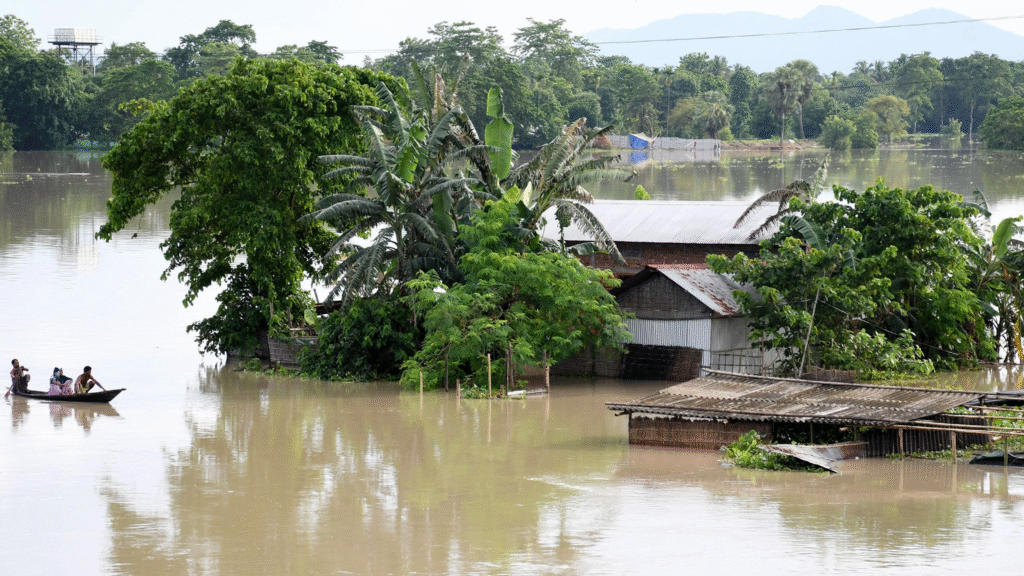
The northeastern state of Assam is once again in the throes of a catastrophic flood season, with over 3.64 lakh people across 19 districts bearing the brunt of nature’s fury. The ongoing deluge has submerged homes, ravaged farmlands, and disrupted lives, casting a grim shadow over the region. With incessant rains showing no signs of abating, the crisis underscores the urgent need for comprehensive disaster management strategies in this flood-prone area.
The Scale of Destruction
Assam’s flood woes are an annual ordeal, but the current situation is particularly grim. Rivers like the Brahmaputra and its tributaries have swollen beyond danger levels, inundating vast tracts of land and displacing tens of thousands of residents. Entire villages have been submerged, forcing families to abandon their homes and seek refuge in relief camps or temporary shelters.
As per the Assam State Disaster Management Authority (ASDMA), the affected districts include Dhemaji, Lakhimpur, Dibrugarh, and Majuli, among others. These regions, primarily agrarian, are witnessing widespread devastation, with standing crops destroyed and livestock swept away. Early estimates indicate that over 1.2 lakh hectares of farmland are under water, jeopardizing the livelihoods of thousands of farming families.
The magnitude of the devastation is evident in the faces of those displaced. Families are seen wading through waist-deep waters carrying whatever belongings they could salvage. Schools, places of worship, and community centers have been turned into makeshift shelters, accommodating people from the most vulnerable sections of society. However, the resources are inadequate, and the demand far exceeds the supply of essential commodities.
A Humanitarian Crisis
The deluge has brought with it an unprecedented humanitarian crisis. Rescue operations are underway, but the sheer scale of the disaster has overwhelmed authorities. Over 60,000 people are currently housed in relief camps, where they are grappling with overcrowding and limited access to essentials like food, clean drinking water, and medical supplies.
Health concerns are mounting as waterborne diseases such as diarrhea and cholera begin to emerge. Medical teams are working tirelessly to address these challenges, but the lack of infrastructure in remote areas is hampering their efforts. Additionally, the psychological toll on affected families, particularly children, is immense, with many grappling with trauma and uncertainty about their future.
In many areas, the lack of clean drinking water has led to residents relying on floodwater, exacerbating the risk of disease outbreaks. Hospitals and clinics in flood-hit regions are overwhelmed, struggling to cope with the influx of patients. The state’s health department has issued urgent advisories to residents to boil water before drinking and avoid wading through floodwaters wherever possible.
Government and Community Response
The Assam government, in coordination with the National Disaster Response Force (NDRF) and local agencies, has ramped up relief efforts. Boats and helicopters are being deployed to rescue stranded individuals and deliver supplies to hard-to-reach areas. Financial aid has been announced for affected families, and measures are being taken to provide fodder for livestock.
Community members and volunteers are also playing a pivotal role in relief operations. Local NGOs and social organizations have mobilized resources to distribute food packets, water, and hygiene kits. Crowdfunding campaigns have been launched to support relief efforts, highlighting the solidarity and resilience of the people of Assam.
Despite these efforts, the situation on the ground remains dire. Many residents complain of delays in receiving aid and the lack of coordination among authorities. Relief camps, although a temporary reprieve, are overcrowded, and sanitation facilities are inadequate, posing further health risks.
Economic Implications
The economic impact of the floods is staggering. Agriculture, which is the backbone of Assam’s economy, has been severely affected. Paddy fields, tea plantations, and vegetable crops have been submerged, leading to significant financial losses for farmers. Many of them are now dependent on government assistance to rebuild their lives.
The tea industry, a major revenue generator for the state, has also taken a hit. Several tea gardens have been inundated, disrupting plucking and processing activities. This could have long-term implications for the industry, which employs thousands of workers and contributes significantly to the state’s economy.
Infrastructure has also borne the brunt of the disaster. Roads, bridges, and embankments have been damaged, cutting off access to several areas. Power outages and communication breakdowns have further compounded the challenges, making it difficult for relief teams to reach remote villages.
Small businesses and vendors, reliant on daily earnings, have been particularly affected. Marketplaces remain closed, and supply chains are disrupted, further exacerbating economic hardships. For many families, the floodwaters have not only taken away their homes but also their means of livelihood, plunging them into uncertainty.
Environmental and Ecological Impact
The floods have wreaked havoc on Assam’s unique biodiversity. Kaziranga National Park, a UNESCO World Heritage Site, is among the areas affected. The park, home to the endangered one-horned rhinoceros, has been submerged, forcing animals to seek higher ground. While some animals have managed to escape, others have fallen prey to the rising waters or poachers taking advantage of the chaos.

The Brahmaputra River, which is both a lifeline and a source of devastation for the region, has once again highlighted the urgent need for sustainable river management. Experts have long warned about the impact of deforestation, unplanned construction, and climate change on Assam’s flood patterns. Addressing these issues is critical to mitigating future disasters.
Furthermore, the siltation of riverbeds has reduced the carrying capacity of rivers, making them prone to overflow. The loss of vegetation along riverbanks has also exacerbated erosion, further contributing to the crisis. Conservationists are urging immediate action to restore the natural ecosystems that act as buffers against flooding.
Voices from the Ground
Amidst the destruction, stories of resilience and courage are emerging from affected communities. In one village in Dhemaji district, a group of youths used makeshift rafts to rescue elderly residents trapped in their homes. In another instance, women in a relief camp organized themselves to cook and distribute food for fellow displaced families.
However, the challenges remain immense. “We lost everything in a matter of hours,” said Ramesh Das, a farmer from Lakhimpur. “Our crops, our home, even our savings are gone. We don’t know how we will survive.”
Children in relief camps are among the most vulnerable. Displaced from their homes and schools, they face disruptions to their education and daily routines. NGOs and volunteers are stepping in to provide informal education and recreational activities to help them cope with the trauma.
Looking Ahead: The Need for Long-Term Solutions
While immediate relief efforts are crucial, the recurring nature of Assam’s floods calls for a long-term approach to disaster management. Experts advocate for a multi-pronged strategy that includes the construction of robust embankments, dredging of rivers, and the implementation of advanced early warning systems.
Additionally, promoting sustainable agricultural practices and diversifying livelihoods can help reduce the economic impact of floods on farming communities. Enhancing community awareness and preparedness through education and training programs is equally important.
Urban planning also needs a radical overhaul to prevent waterlogging and flooding in cities. Improved drainage systems, zoning laws, and strict regulation of construction activities near water bodies are vital steps toward flood mitigation.
The Role of Technology and Innovation
Innovative solutions can play a vital role in mitigating the impact of floods. Satellite imagery and drone technology, for instance, can be used to map flood-prone areas and monitor water levels in real-time. Mobile apps and SMS alerts can provide timely warnings to residents, enabling them to evacuate to safer locations.
Collaboration with international organizations and experts can also provide valuable insights. Countries like the Netherlands and Bangladesh, which have successfully managed flood challenges, can offer lessons and best practices that can be adapted to Assam’s unique context.
Investments in research and development are equally important. Developing flood-resistant crops and improving irrigation techniques can help minimize the impact on agriculture. Similarly, constructing elevated homes and infrastructure can provide a buffer against rising waters.
Conclusion
As Assam battles yet another devastating flood season, the resilience and determination of its people shine through. However, the recurring nature of these disasters highlights the urgent need for a paradigm shift in how we approach flood management. By investing in infrastructure, embracing technology, and fostering community engagement, we can hope to build a safer, more resilient Assam.
The road to recovery will be long and arduous, but with collective efforts and a commitment to sustainable development, Assam can emerge stronger and better equipped to face future challenges.
The need of the hour is to prioritize the well-being of affected families and ensure that relief and rehabilitation efforts reach every corner of the state. With the right policies and the collective will of the people, Assam can transform its flood-prone regions into hubs of resilience and sustainability, setting an example for the rest of the country.

